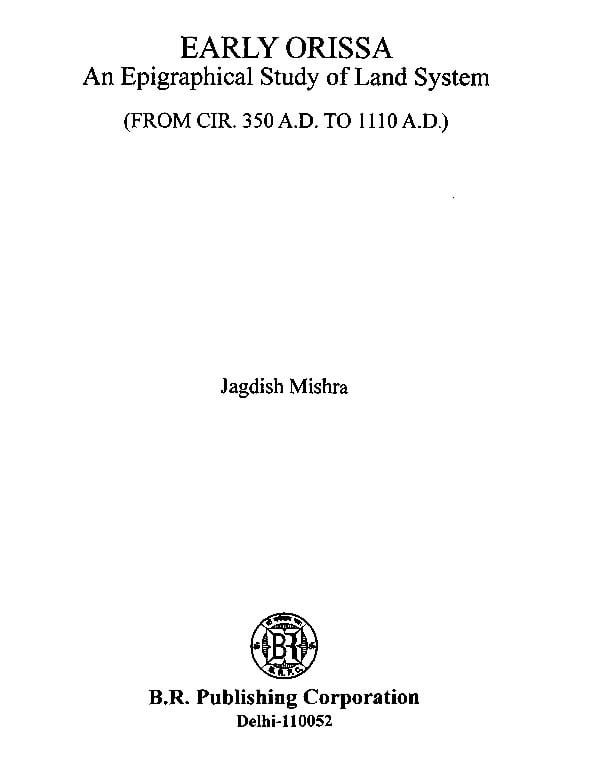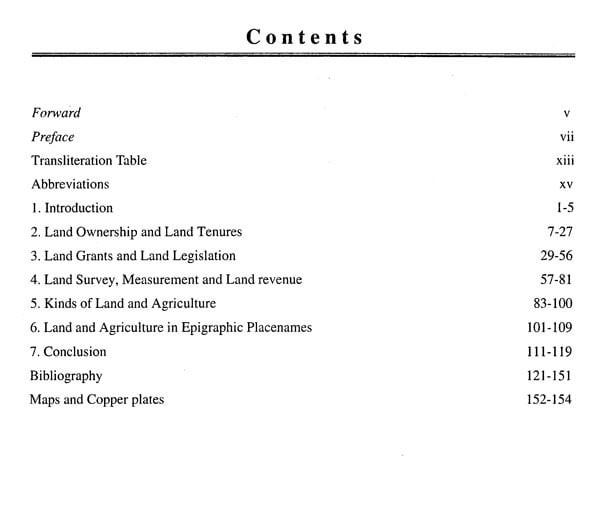
Early Orissa- An Epigraphical Study of Land System From CIR. 350 A.D. to 1110 A.D.
Book Specification
| Item Code: | AZE647 |
| Author: | Jagadish Mishra |
| Publisher: | B.R. PUBLISHING CORPORATION |
| Language: | ENGLISH |
| Edition: | 2011 |
| ISBN: | 9788176467728 |
| Pages: | 166 |
| Cover: | HARDCOVER |
| Other Details | 11.00x9.00 |
| Weight | 720 gm |
Book Description
So many scholars have undertake research several aspects political on socio-economic history came later. Land system a part of economic history. Historians though have discussed the economic history, have concentrated land system. few scholars have devoted their time and energy the study land system in Indian context. In the field Orissa history, was desideratum. In this context a study land of Orissa ideal and timely. Mishra has the problem successfully elucidates the history and complexities with befitting explanation of the land system this As a vast topic Dr. Mishra has rightly restricted only epigraphical evidences and the period from CIR. 350 A.D. 1110 A.D. from the Mithras to the advent imperial Gangas. For corroboration his epigraphical study has consulted necessay literary texts. hope will serve a helpful reference future research. is a good contribution the Homain of economic history Orissa well as of India.
Land is one of the basic needs of the people. From the day of man’s appearance on the earth to till today land has occupied Unique position. In course of time, become the basic quality his standard of living. is quite clear the fact that, his life starts the cradle with the earth and ends when is finally cremated on the ground Land sustains his whole life. is the most important necessity of from cradle grave.
In the evolutionary process civilization a place the importance land increased. Land came to used different purposes. With growth kingship unclaimed land was brought under state control on private land collected revenues. Kings also donated land exempted from all taxes to different domes this context the region now called Orissa which was greater ancient present position, experienced same process of development. was then divided into petty political kingdoms like Kalinga, Košala, Utkala, Odra, Kangoda etc. witnessed rise and fall many ruling dynasties like Nandas, the Mauryas, the Chedis, the Mithras, Nalas, Somavamsis, the and Gangas etc. between 350 A.D. and A.D., good number of particularly copper plate were them which endowments made land. those land grants brought light so far contain minute information regarding kinds of land, ownership and tenures, measurement, revenues, legislations agriculture. Further, they mention the names places of their donated land either cultivable or tract etc., explaining the land system prevalent then.
All inscriptions reveal the significance of past. recognises importance of land on the very existence Thus, which is important branch of economy in no case is important section history. For reason study of land system on the basis epigraphic evidences seems to be useful. More it helps us correlate the with the past. It means understanding of can help correct many prevalent in the land structure today which have harmful effects on our economic condition. Besides we can adopt many good practices of our ancient past that are being practiced present.
At the very first stage of human evolution, man's life was almost equal to that of wild beast He was living in jungles in the company of the wild animals, eating their raw flesh and fruits and vegetables that grew in the wild jungle. Like animals he was a nomad, taking shelter here and there. Neither did he have home to take rest like civilized people nor he knew how to wear dresses. cook food, pasture cattle and do agriculture. Even the art of making fire was not known to him. Accumulation of wealth, precious metals. Properties, private lands were beyond his imagination. The sole purpose of living was to fill up the belly by any means at the cost of his physical labor.
Change is the inherent characteristic of human life. In the evolutionary process of time, his ideas, intellect and style of living developed. Social set up evinced such a change where man began to live a purposeful life. He distinguished his nature from that of wild beasts. Thus, after the lapse of thousands of years he reached to a new stage of life, i.c. the neo-litchi age which marked the transition of man from a nomadic life to an agricultural life. Man began to produce his own food. Also finely polished and fairly executed implements were made and domestication of animals began. Man learned the art of making fire and potteries of both handmade and wheel turned.
The neo-litchi age was replaced by chalco-lithic age in which man came to know the use of metals. It was during this stage real civilisation began. Man lived at a place permanently, occupying certain amount of land for home stead, for cultivation and for different other purposes.
**Contents and Sample Pages**












